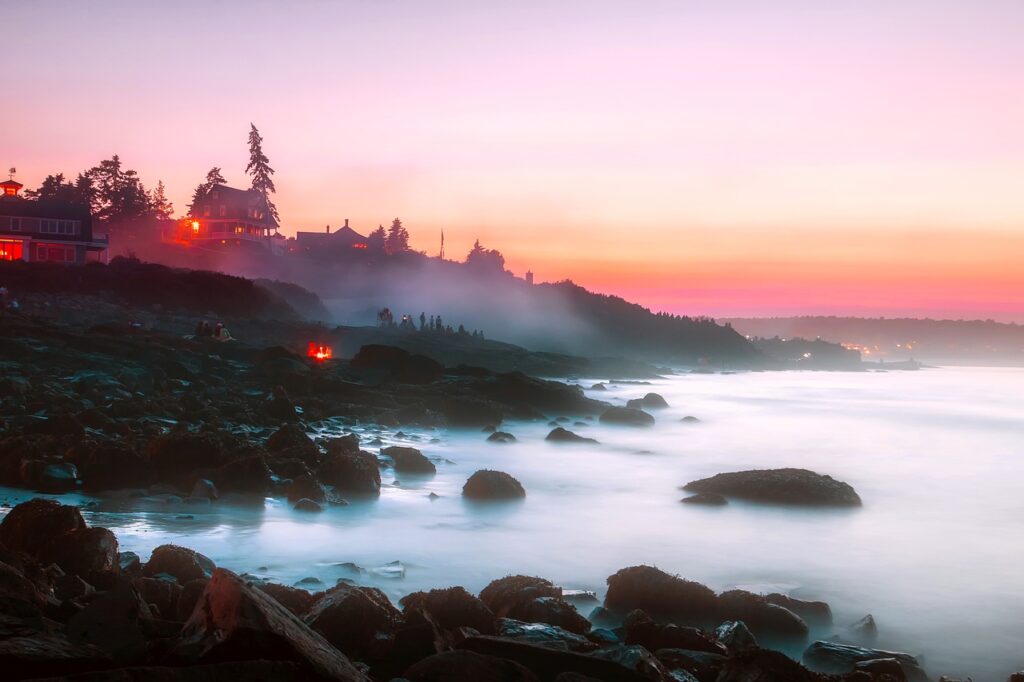
Cape Anne to Cape Cod: Rocky Shores to Rolling Dunes
Are you wondering where you’ll wander next? This weekend to weekend route takes the guessing out of where to stay and what to see on a week-long road trip through Massachusetts.
With the exception of Hawaii and North Dakota, we’ve wandered through each U.S. state, but it’s the New England region that lures us back every few years. No matter how we plot our route or how many times we return, we never get our fill of the history, the mountains, the trees, the trails, and the unique charm of each small town and its characters. At each trip’s end, we discover how much more we’ve yet to see.
We’ve explored the six New England states from several vantage points, usually with Boston’s Logan airport as the starting point. We’ve followed the coastline north into New Hampshire and up to Bar Harbor, Maine. We’ve traveled southeast to Cape Cod making Hyannis Port our home base. Here, we explored points east to Provincetown, west into Rhode Island, with ferry rides to Nantucket and Martha’s Vineyard. We’ve looped through Vermont and Connecticut twice on journeys through the Adirondacks and the Hudson River Valley, once in the spring and more recently this past October. In addition, we’ve traveled to Boston half a dozen times for job-related activities.

Consequently, we’ve concluded that exploring all New England has to offer would take at least four weeks. If we could relive our travels, this is how we would tackle the region to save time and money:
- One week devoted to the pristine wilderness and seaside villages along the rugged coastline of Maine
- One week devoted to the Norman Rockwellesque appeal of Vermont, New Hampshire, the Massachusetts Berkshires, and inland Connecticut
- One week devoted to the seaside ambiance of Connecticut, the Gilded-Age splendor of Rhode Island, and parts of Boston
- And, one week devoted exclusively to Massachusetts— the focus of this article.
From the rocky shores of Cape Ann to the rolling dunes of Cape Cod, this 300-mile round-trip road trip highlights the history and beauty of Massachusetts as it captures some of New England’s most renowned landmarks and unique spirit. The following eight day route fits easily into a Saturday to Saturday vacation schedule and takes cost, time, and distance into consideration.
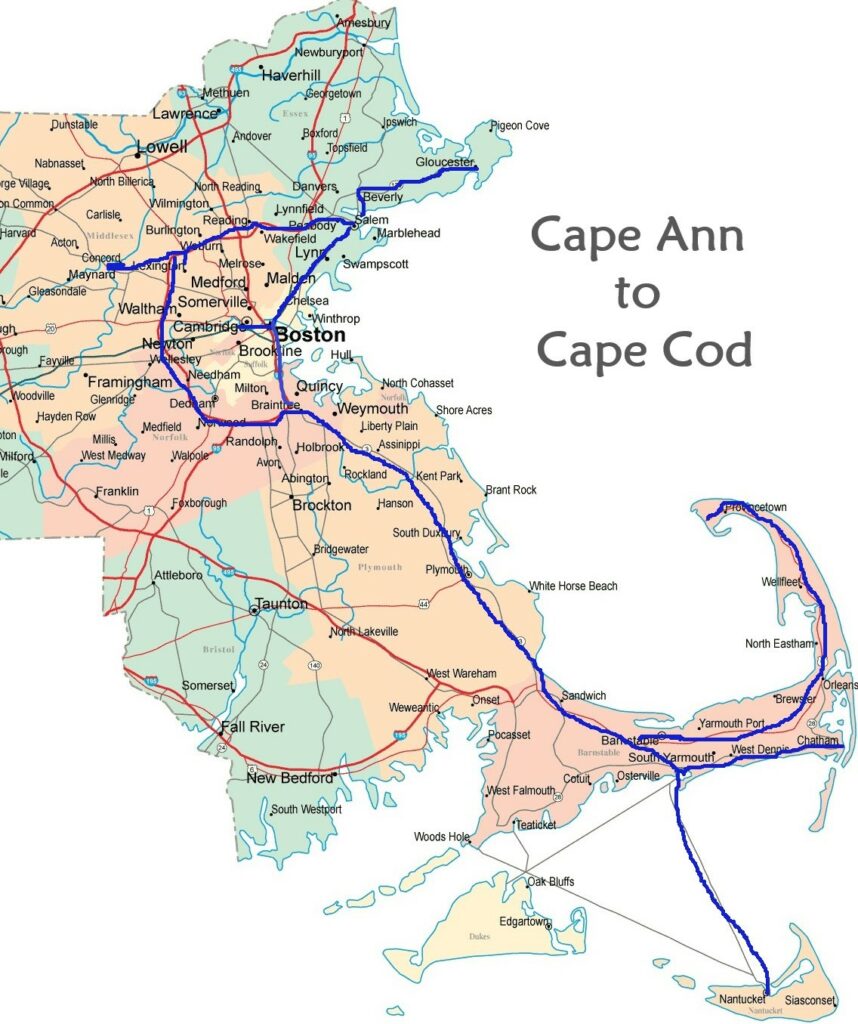
Public Domain/Map Resources
First, Save $$$: Book These Two Hotels Weeks Before Departure
We despise traveling from hotel to hotel for a single night’s stay. We call these travel stops “one night stands” and the constant repacking wears us out. Instead, we prefer to establish “roots,” even for just a few nights. The hotel staff gets friendlier each day and we can wash out our underwear in the sink and it’s dry by evening –TMI, I know.
Every destination on this particular trip is in close proximity to Boston, but its hotel rooms are pricey any night of the week, especially on Friday and Saturday stays. To conserve time and money as well as maximize comfort, we recommend booking two hotels for this seven-night trip—The Salem Waterfront Hotel north of Boston and the Hampton Inn and Suites Cape Cod-West Yarmouth southeast of the city.

Make sure you book directly with each hotel rather than a third party site. The deals will be just as good, and you will avoid the booking issues and miscommunication that often result when a room is secured through an outside source.
Four Nights at the Salem Waterfront Hotel:
Although a number of lovely establishments dot the coast north of Boston, the nautical-themed Salem Waterfront Hotel only twenty minutes north of Boston has been our first choice on two occasions for these reasons:
- It’s a ten-minute walk from nearly every historic site in Salem.
- It’s only 20 miles north of Boston, and ideally located for exploring northern Massachusetts, New Hampshire, and southern Maine within an easy day’s drive.
- It’s approximately $100 less a night than many Boston hotels of the same caliber–even if you choose the junior suite with a king bed, refrigerator, and microwave (AAA and AARP rates available).
- Its onsite pub, the Regatta, serves great food including breakfast–(ask for the bed and breakfast package when you book directly).
- While the hotel actually sits on Pickering Wharf rather than a waterfront, this hotel is a comfortable, cozy place to spend the first four nights of your seven-night trip.
Three Nights at the Hampton Inn and Suites Cape Cod–West Yarmouth:
Of the many family-owned motor inns and bed and breakfasts located from stem to stern on the Cape Cod peninsula, our quest for Hilton Honors points won out on our last trip to the region. We booked an enjoyable week at the Hampton Inn and Suites Cape Cod–West Yarmouth about 90 minutes southeast of Boston for these reasons:
- It’s practically a stone’s throw from Hyannis Port and a mere mile to its harbor.
- You can reserve a spacious king studio suite with a wet bar, mini fridge, and microwave for nearly $100 less per night than the hotels close by with an ocean view. (Believe me—you’ll experience plenty of ocean on Cape Cod.)
- It has an exceptional fitness room.
- It’s about 90 minutes southeast of Boston–plenty of time to catch a plane home from Boston Logan in the later afternoon when your final vacation day arrives.
- It’s conveniently located off Highway 28, a main road that begins near the neck of the Cape Cod peninsula and connects numerous small towns along the southern coast.
We love the little shops and mom-and-pop eateries that line this route as it stretches from Falmouth to Orleans. Then, the road turns inward once again where it meets up with the Mid-Cape Highway 6 and continues on to Provincetown.
DAY 1: Destination Salem Via Boston
Is conserving vacation days your top priority? Finding a low-cost flight to Boston’s Logan airport is your best option. Plan a flight that arrives in the early afternoon and reserve your rental car for an evening pick-up to allow an afternoon in Boston. (Yes, —rent a car. Although you won’t rely on it extensively until Day Three, you’ll travel from point to point more efficiently than subjecting yourself to the mercy of mass transportation outside of Boston.) On your first afternoon, however, you’ll find the transportation options within Boston quite satisfactory.
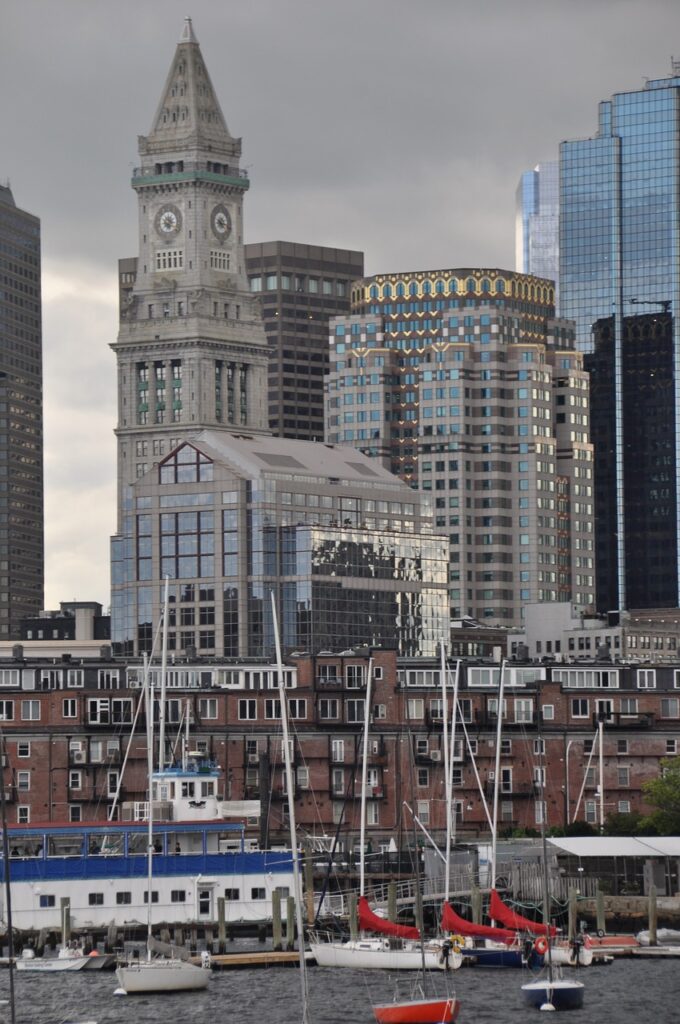
With your luggage in tow, take the airport’s free shuttle to the harbor for a water taxi or the Airport station subway to the Aquarium stop.
Of course, you won’t want to lug your luggage around the city. Although we rented an airport locker and stowed our belongings for a layover in the past, Logan Airport no longer offers this feature. However, if you make the short ride from the airport into Boston city center via Rowe’s Wharf Water Transport service, the company provides secure storage for your belongings while you enjoy your afternoon in the city. Again, with your luggage in tow, find your way via the complimentary #66 shuttle to the wharf using this link. Reservations are recommended. Search for the winter hours if you are traveling after October 30.
Note: If flying isn’t an option and you are driving several days from home, park your car at one of the outlying MBTA subway stations to avoid the stress of searching for a parking spot in downtown Boston. At $9 per parking spot per day, you’ll avoid the premium price a prime spot in the city commands. Take the subway from your station to Aquarium station for easy access to the sites noted below.
Planning Your Afternoon in Boston
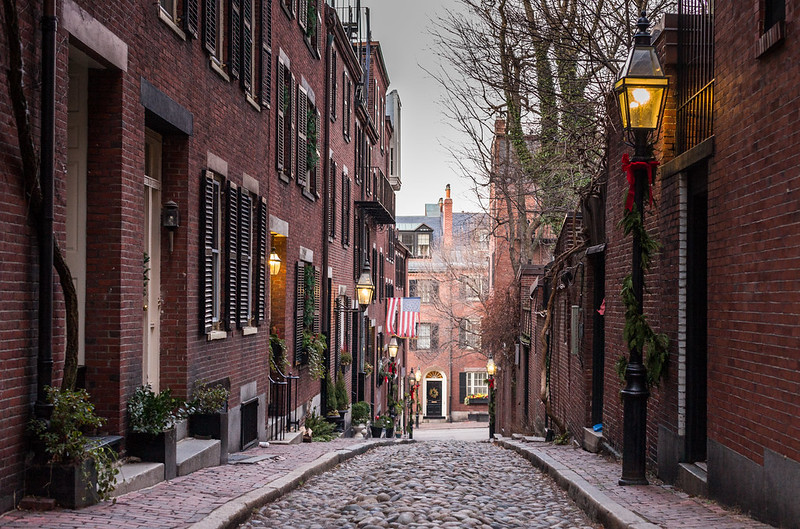
You could easily spend an entire week exploring Boston and its many boroughs full of New England character.
One of the first characteristics I noticed about this fascinating city is its quirky system of streets in the oldest areas of the town—odd turns and angles, some cobblestoned, much like the lanes in Old London centuries ago which surely influenced Boston’s development. In fact, some of the 400-year-old streets have names identical to streets in London–Milk Street, Argyle Street, Bird Street, and Henchman Street, for example.
You should plan to visit one of Boston’s many historical or cultural venues each time you are in close proximity of the city, and this trip route allows several opportunities.

Whether you arrive at Rowe’s Wharf by water taxi or the Aquarium subway stop next to the wharf, you are within two blocks of one of the most popular gathering places in Boston: Fanneuil Hall Marketplace with its weekend street performers and the Quincy Market Food Colonnade featuring specialties from many of the city’s iconic restaurants. Furthermore, key historic sites along the Freedom Trail are within a half mile walk from the markets including Paul Revere’s House, the Old North Church immortalized by Longfellow’s poem, “The Midnight Ride of Paul Revere,” and Granary Burial Ground.
Before you journey back to the airport to retrieve your rental car, conclude your afternoon at one of our two favorite restaurants in Boston– the Black Rose. Boston’s premiere Irish pub for the past forty years, the Black Rose features inexpensive authentic Irish food and live music nearly every night of the week. It’s a short block east of Quincy Market.
Once you return to the airport and are behind the wheel of your rental car, the Salem Waterfront Hotel is approximately 15 miles, but allow 30 minutes driving time.
DAY 2: The Bewitching Sites of Salem
After a restful night’s sleep and breakfast in the hotel’s Regatta Pub, it’s time to explore historic Salem. Because the majority of the public historic sites are within easy walking distance of the hotel, you can take your day at a comfortable pace.

Founded in 1626, Salem was once the most important seaport in the New England colonies. However, the city’s maritime contributions were overshadowed in 1692 when minister Samuel Parrish fanned the fire of suspicion that witchcraft was practiced in Salem. He claimed his young daughter, Bette, and niece, Abigail Williams, had fallen victim. As the year progressed and the trials were conducted, nearly two hundred individuals stood accused. Thirty were found guilty, and fourteen women, five men, and two dogs were hanged or crushed to death as witches.
Today it’s hard to imagine that superstition could drive a group of people to such extreme measures, but journalist Stacy Schiff paints a bleaker picture of the New England that existed over three centuries ago. She suggests it was fertile ground for unbridled imaginations in the framework of Puritan fervor: “In isolated settlements, in smoky, fire-lit homes, New Englanders lived very much in the dark, where one listens more acutely, feels most passionately, and imagines most vividly, where the sacred and the occult thrive” (“Inside the Salem Witch Trials”).

Centuries later, of course, the witch trials are regarded as a lesson of the consequences of mass hysteria and failure to provide due process. In fact, as the generations passed and the tragic injustice of the trials were put in perspective, the city’s elders apparently considered the commemoration of Salem’s dark past unthinkable. In their book Salem: Place, Myth, and Memory, editors Dane Anthony Morrison and Nancy Lusignan Schultz write, “the shame and the guilt of the trials–not withstanding heroic revisions during the colonial revival–still outweighed the benefits of selling Salem’s curious and inexplicable history” (55). The editors also note that when Arthur Miller arrived in 1952 to gather research for The Crucible, he reported, “You couldn’t get anyone to say anything about it” (qtd. in Morrison and Lusignan 55).
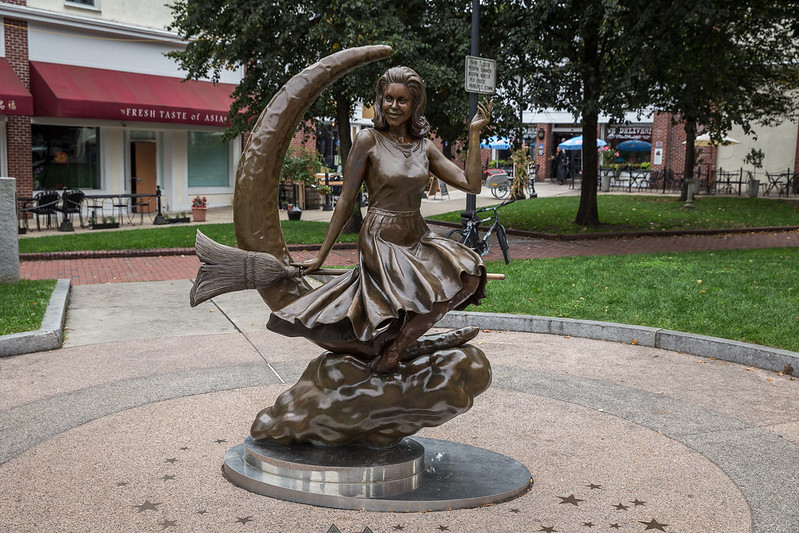
Ironically, the television show Bewitched is credited with helping Salem come to terms with its horrific past, notes Stacy Schiff in another article–an op-ed for the New York Times. She remembers the 1970 episode when main character Samantha Stevens (Elizabeth Montgomery) travels to modern-day Salem with her husband Darrin (Dick Sargent) on vacation, but soon her twitching nose finds her transported to the past where she is shackled and put on trial. Samantha chastises her accusers: “The people that you persecuted were guiltless. They were mortals, just like yourselves. You are the guilty,” (qtd. in Schiff, “First, Kill the Witches“). And, Schiff concludes, “Not for the first time, it fell to a fiction to restore the history. . . . In Samantha’s wake, Salem recast its inglorious past, or at least some version of it.”
The estimated one million tourists who visit Salem annually now find two distinctive narratives have arisen from the town’s dark past. One reverences the innocence of the victims and condemns their accusers. The other celebrates witchcraft and other New Age doctrine and even profits from it. Since 1970, Salem has attracted many practicing Wiccans who have formed approximately thirty covens according Tom Dalton for the Salem News. Now, witchcraft academies and seminars attract many followers along with entrepreneurs selling witchcraft paraphernalia including potions, herbs and crystals. Journalist Tara Isabella Burton notes, “There weren’t any witches in Salem in 1693. But, there sure are now.”
Mapping Out Your Day in Salem
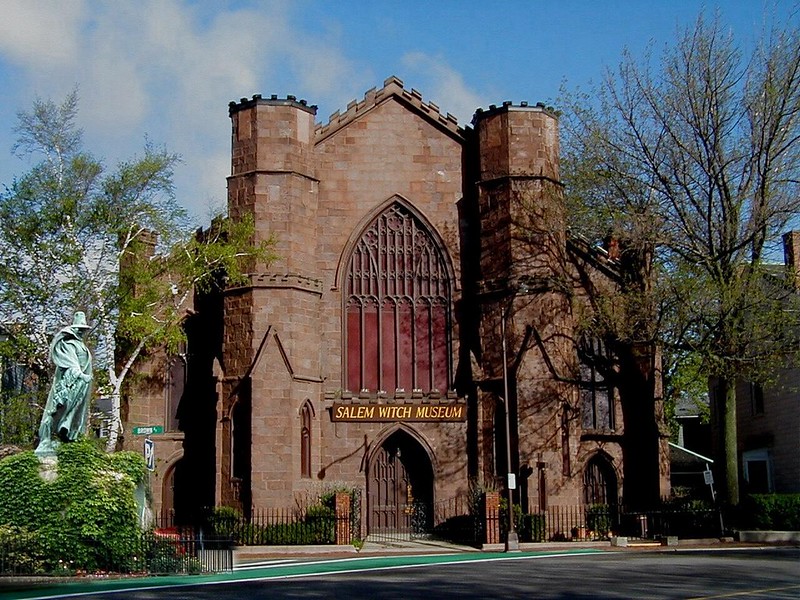
Image by Massachusetts Office of Travel and Tourism. CC / Flickr
Begin your day with a short walk three blocks north of the hotel to the National Park Regional Visitor Center at 2 New Liberty Street for an overview of the town’s many attractions. The short orientation film at the visitor’s center and the engaging presentation at the nearby Salem Witch Museum strive to educate audiences about the tragedy of the 1692 witch trials rather than exploit and capitalize on the town’s most famous event. Judge Corwin’s House, often referred to as the Witch House, is a short distance from the Visitor Center and the Salem Witch Museum. Nearly four centuries old, it’s the only authentic structure in existence that has a direct connection to the trials—its owner Jonathan Corwin, was the presiding judge.
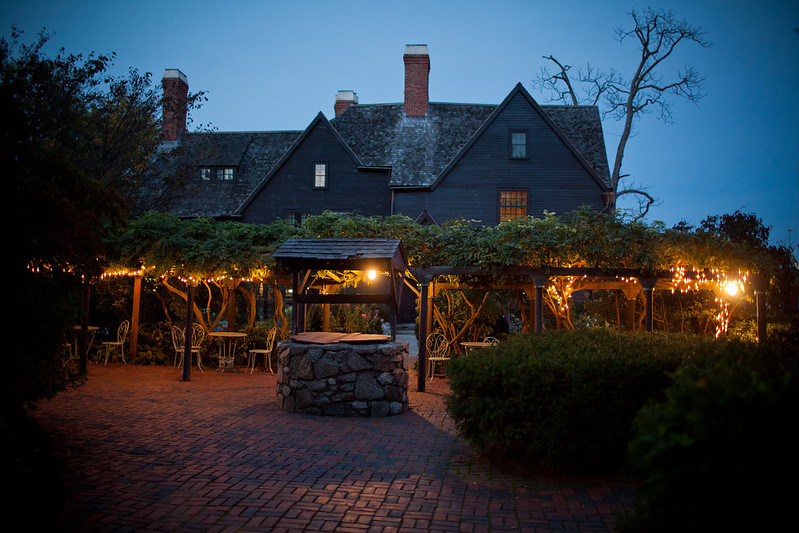
Image by Massachusetts Office of Travel and Tourism. CC / Flicker
After lunch, head one block east of the hotel to Salem’s Maritime National Historic Site, and two blocks further to The House of the Seven Gables, the former home of Nathaniel Hawthorne’s cousin and the inspiration for his book with the same title published in 1851. Or browse the many antique and novelty shops. Our favorite is the Pickering Wharf Antiques Gallery at 69 Harbor right across from the hotel.
We were sad to learn that the Victoria Station Restaurant closed in 2017, but we’ve learned since that Finz Seafood and Grill has taken its place on a prime location on Salem Harbor–not even a block from your hotel. (Please note our recommendations are based strictly on Trip Advisor reviews, but we hope to add our own positive review when we return for a Cape Cod vacation with our family in 2021.)
And finally, as the day comes to a close, there are some fascinating evening walking tours of the city. Conduct a bit of research to find a tour suited to your comfort zone–one that focuses more on history or one that highlights Salem’s alleged hauntings.
We had an excellent experience on our night tour in 2016. Our guide was actor, Giovanni Alabiso who moonlights after his day job, capitalizing on his love of local history and lore. He’s also the president of Salem Historical Tours, Salem’s original tour company established in 1997.
DAY 3: Cape Ann Featuring Gloucester and Rockport
After another breakfast in hotel’s Regatta Pub, a drive farther north along Massachusetts rugged and rocky Cape Ann coastline is the plan for the new day. This route includes stops at two of the region’s small and picturesque seaport towns, central to the fishing industry for several centuries.

The first stop is Gloucester, the nation’s oldest seaport. Here you’ll find the often photographed Fisherman’s Memorial, a poignant tribute to over 3000 New England fisherman who have lost their lives at sea, including the six-man crew of the Andrea Gail who inspired the film, The Perfect Storm. One of the first communities founded in the Massachusetts Bay Colony in approximately 1642, Gloucester’s roots are even older than Salem’s. You’ll have to make some choices regarding how you’ll spend your morning in this 400-year-old town.

Consider taking Gloucester’s self-guided harbor walk, a mile and a half route that features 42 granite story posts offering details about the town’s history. Then, check out Gloucester’s three-story Cape Ann Museum offering an extensive history of the town’s fishing and granite industries as well as art exhibits the region has inspired. In addition, Gloucester is home to two of New England’s oldest lighthouses: Anisquam Harbor Light and Eastern Point Lighthouse. Because all six of Cape Ann’s lighthouses are closed to the public, a three-hour Cape Ann Harbor Tour is the best way to learn about their history as well as the story of Cape Ann (you can visit several lighthouses on Cape Cod). In addition, Gloucester features Beauport, the Sleeper McGann House, one of the quirkiest architectural delights situated high on a ledge overlooking the harbor, open to the public, May through October.

Your day’s 50-mile round trip journey also includes a stop in Rockport about ten miles north of Gloucester. This link provides seven self-guided walking tours including Bearskin Neck where you can peruse the shops and galleries and make one or two essential stops for afternoon coffee (and pastry) at Helmut’s Strudel or The Bean and Leaf Cafe. And, whether you choose lunch or dinner as your day’s big meal, we recommend the Seafood Grill at 6 Harbor Rowe in Gloucester where the baked haddock melts in your mouth.
DAY 4: A Second Look at Boston
There’s still much to see in Boston, and if you’re visiting between mid-May and October 31, the most convenient means of travel is by Salem Ferry. The departure point is a quick four-walk block from the hotel east on Derby Street–past the House of Seven Gables you toured on Day Two. There are four ferry departures daily starting as early as 7:00 am from Salem and returning as late as 5:30 on weekdays and later on weekends from Boston Harbor.

Or, if you choose to drive, keep in mind that parking is a BIG issue in downtown Boston. If it’s necessary to drive into the city, it’s best to park at an outlying T-stop like Wonderland station on Boston’s Blue Line approximately 10 miles from Salem. All day parking is only $7 on the weekdays and $2 on the weekend. For a little over $2 a person, this station will take you straight into the city to the Aquarium stop and the New England Aquarium, just footsteps from Rowe’s Wharf where you landed on Sunday. In turn, this stop is footsteps from the ticket booth for one of the best ways to view Boston, an Old Towne narrated Trolley Tour. These tours highlight many landmarks including Boston’s Little Italy, the USS Constitution, the Cheers Bar, and Fenway Park.
We Recommend a Visit to Charleston in the Afternoon
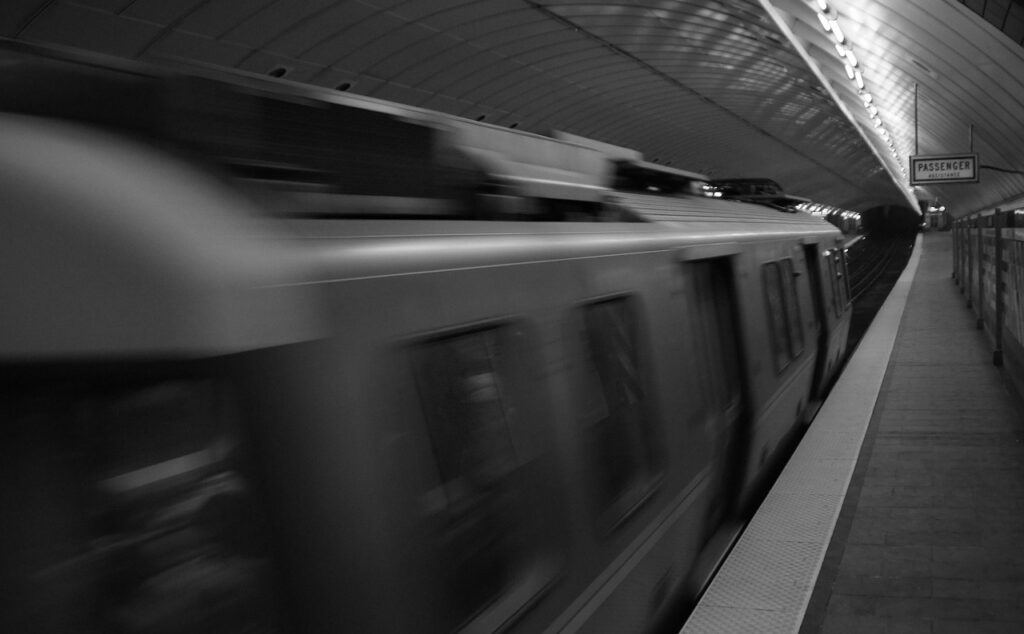
If you plan the two-hour trolley tour for the morning, we recommend a visit across the St. Charles River via the Red Line in the afternoon. To do this, locate the Downtown Crossing or Park Street subway stops and take the MBTA’s Alewife train on the Red Line to Harvard Square. And by the way, we applaud the MBTA’s subway system–safe, reliable, and relatively clean. We never have any qualms riding the T.
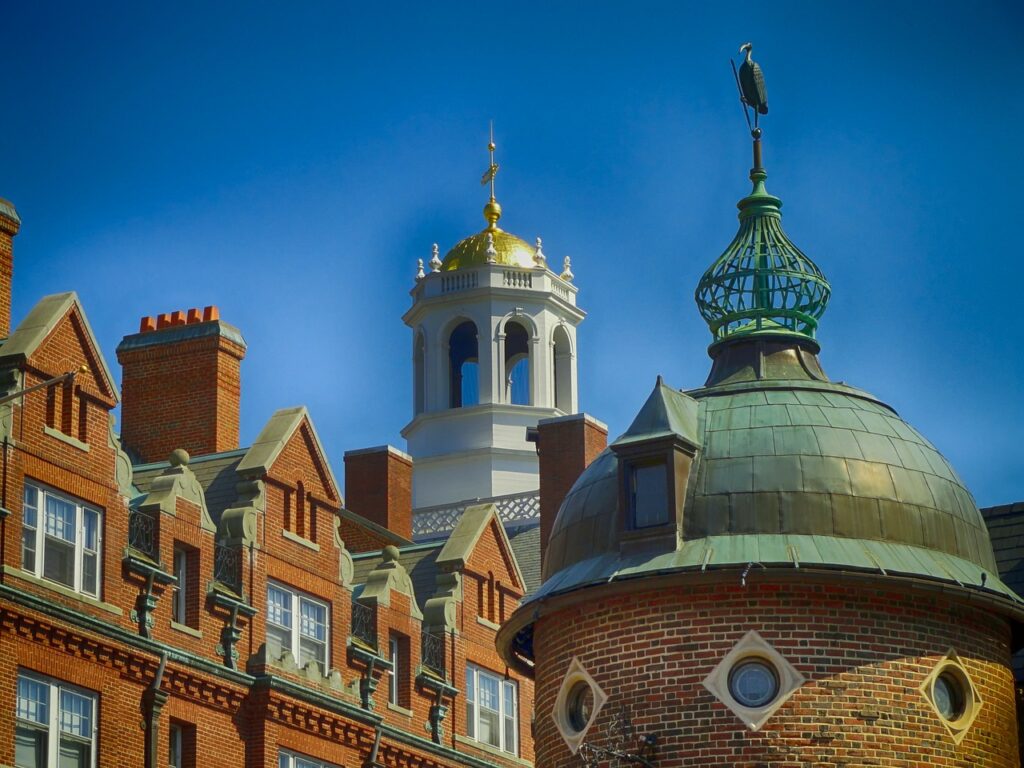
When you climb the stairs out of the Harvard Square subway stop, you’ll find yourself at the gates of Harvard University. Here, you can stroll leisurely across this lovely campus and admire some of the architecture gracing its centuries-old ivory-covered buildings. One option for the afternoon is to cross the campus to Oxford Street and the university’s Museum of Natural History.
Longfellow’s Home
As another option, you can enjoy the academic vibe in the coffee shops and trendy stores along Massachusetts Avenue and walk approximately three blocks to my favorite Boston-area attraction, Henry W. Longfellow’s home at 105 Brattle Street. Not only was this elegant Georgian house the beloved poet and Harvard professor’s home for nearly 50 years, it served as General George Washington’s Headquarters during the siege of Boston in 1775-1776. If you’ve never connected with Longfellow’s work, the tour’s engaging narrative and the authentic furnishings and artifacts, all with a story, will quickly endear him to you. In this house, Longfellow and his wife Fanny entertained some of the most renowned figures of the 19th century including Charles Dickens, Ralph Waldo Emerson, Nathaniel Hawthorne, Julia Ward Howe, Jenny Lind–the Swedish Nightengale, and Oscar Wilde who commented, “Longfellow himself was a beautiful poet.”

Read the photographer’s moving tribute to the poet here.
Sadly, the house was also the scene of Longfellow’s greatest tragedy. In 1861, Fanny died in a fire that started when she was melting wax to seal letters containing locks of her children’s hair. Longfellow attempted to save her and suffered serious burns on his face–hence, his signature white beard he wore for the rest of his life to hide the scars.
As the afternoon winds down, and if you haven’t yet had your fill of seafood, take the Red Line back into Boston proper and find your way to the New England Aquarium. From here head north along the Harbor Walk through Christopher Columbus Park, past Joe’s American Bar and Grill, to our favorite mom and pop place in Boston, Boston Sail Loft on the Wharf. Right on the harbor, the ambiance is more rustic than fancy, but the food is as phenomenal as it is affordable.
If you’ve missed the ferry back to Salem, it’s possible to catch the train from North Station to Salem, a comfortable 30-minute ride that runs every one to two hours into the wee hours. Double-check the schedule for departure times. In turn, from Salem’s train platform, the Salem Waterfront Hotel is approximately five blocks south down Washington Avenue and two blocks east on Derby.
DAY 5: Cape Cod by Way of Concord and Lexington
Your stay in Salem concludes this morning and Cape Cod is the evening destination, a two-hour drive south and east. But this day also provides the perfect opportunity to visit Concord and Lexington—two communities which have contributed significantly to our American culture, but are often overshadowed by Boston’s many attractions.
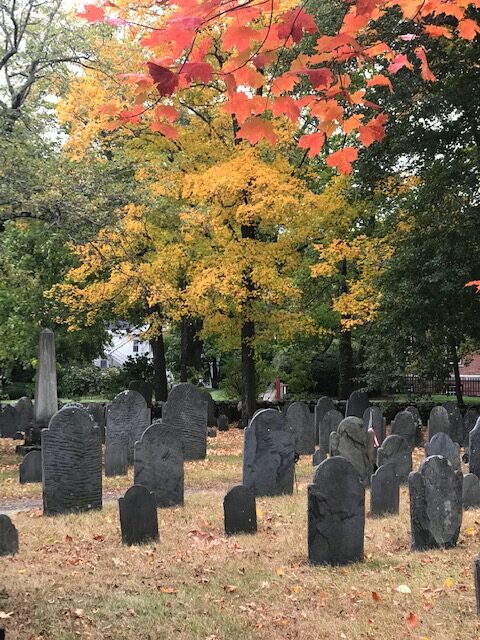
Once your bags are loaded in the car, Lexington is 25 miles west of Salem on Massachusetts’s I 95 and Concord is approximately ten miles farther west. With only one day allotted to these two towns, even with an early morning departure, you will have to make some difficult choices between the many attractions. (We altered our itinerary to spend a second day this past October. We still didn’t see all we wanted to see.)
Both Concord and Lexington were established nearly 400 years ago by British settlers who were among the first to take a stand against England for our country’s independence. The Battles of Concord and Lexington played out in these two communities in April of 1775 where “the shot heard round the world” triggered the Revolutionary War.
It’s the literary history of Concord that caught me off guard, however.
Ode to Sleepy Hollow Cemetery
As we drove down Concord’s Emerson Road, I was mesmerized by this serene little town with its ancient oaks and elms towering over well-manicured saltbox and federalist-style houses. But it’s when we passed through a stone gate off of Bedford Street and made our way up the steep path to a hill in Sleepy Hollow Cemetery that I was gobsmacked. Some of the greatest minds who have shaped our American culture all lived together here in Concord over a century and a half ago—Ralph Waldo Emerson, noted abolitionist Bronson Alcott and his daughter Louisa May Alcott, Nathaniel Hawthorne, Henry David Thoreau and Margaret Sidney. Yes, I knew this, but seeing their names on tombstones in their family plots just a few yards from each other, I was struck by the magnitude of this fact.

I wonder if Emerson himself knew the revelatory power of his words when he spoke before the crowd that gathered to consecrate the new cemetery in 1855, nearly a quarter of a century before he himself was laid to rest a few feet away in his family plot in 1882:
“When these acorns, that are falling at our feet, are oaks overshadowing our children in a remote century,” he stated, “this mute green bank will be full of history: the good, the wise, and the great will have left their names and virtues on the trees; heroes, poets, beauties, sanctities, and benefactors will have made the air tuneable and articulate” (“Address at the Consecration of Sleepy Hollow” 33).
Although a cemetery visit may seem morbid, Sleepy Hollow Cemetery is not to be missed.
An Early morning Sojourn to Thoreau’s Walden Pond
If you are a hiker, we recommend a 7:00 am departure from the Salem hotel for Concord. This allows a peaceful three-mile walk around Walden Pond, the 60-acre lake to which Henry David Thoreau retreated in 1845. Here on land bordering one end of the lake once owned by his friend Ralph Waldo Emerson, Thoreau constructed a small house of wood and lived “simply” for two years, two months, and two days. Mesmerized by the natural world around him, he contemplated man’s purpose, free from the distractions of society. The experience was the inspiration for Walden or Life in the Woods, his collection of essays published in 1854. The visitor center opens at 8:00 am, requires an $8 parking fee, and only 1000 visitors are allowed per day. Its short film, also titled Walden and produced by award-winning documentarian Ken Burns, provides an insightful orientation to the site.

We followed the footpath on a brisk Sunday morning a few weeks back, just as the maples were turning. I had sharp pangs of guilt that our daughter, a fellow English major, couldn’t join us. A lover of all things literary, she of all people would have sensed the joy of autumn’s fresh face and the poetry in the brilliant crimson and gold leaves.
On our arrival shortly before 9:00 am, the parking lot was already filled with cars. We detected German, Italian, and Japanese languages among the many people who crowded into the visitor center for the film that morning. As we rounded the far bend of the pond and looked across the lake at the many small groups finding their way to the lake path, the irony of the view before us came to mind. Thoreau came to this lake 170 years ago to find solitude. However, at this writing, the Massachusetts Department of Conservation limits the number of daily visitors in an attempt to undo the water’s nutrient pollution caused by a century of visitors. As many as tens of thousands flocked to the lake on a typical weekend in the 1950s.
Fortunately, if you schedule a weekend to weekend trip, your Walden Pond visit will fall mid-week with fewer people.
The Concord Visitor Center, the Old North Bridge, and Old Manse

With two hours of morning left, a logical stop after Walden Pond might be the Concord Visitor Center on Main Street, one and a half miles north via Walden Street. Here you’ll find helpful attendants who can make recommendations for your visit to Concord and Lexington and offer various brochures that highlight the town’s 25 historic attractions and trails. All are within walking distance including Sleepy Hollow Cemetery and a replica of the iconic Old North Bridge, now situated on a pedestrian path that arches the Concord River.
The Old North Bridge marks the spot of the first shots fired in the Revolutionary War. Beside the bridge, you’ll find the Battle of Concord’s memorial obelisk constructed in 1837. It was here at a dedication service that same year that Ralph Waldo Emerson delivered his poem, “A Concord Hymn,” Those famous verses immortalized him as a poet as well as an essayist:
By the rude bridge that arched the flood,
Their flag to April’s breeze unfurled,
Here once the embattled farmers stood,
And fired the shot heard round the world. . . .
A quick walk back east on Old North Bridge Road and a few hundred feet along Monument Street will take you to the Emerson’s family home, the Old Manse. This stately Georgian-style farmhouse was constructed by Ralph Waldo Emerson’s grandfather William Emerson in 1770. Here, living with his grandparents as a young man, Emerson composed his famous essay “Nature.” And, in 1842 Nathaniel Hawthorne began his married life with his wife Sophia, leasing the house from the Emerson family for $100 a year.
Be forewarned, with only a few hours left to explore Concord, it’s best you drive rather than walk.
Iconic American Treasures at the Concord Museum

Back on Concord’s Main Street, if you head north to the fork and veer southeast on Lexington Road, you’ll find the Concord Museum on your right. Although small, the museum includes some of the most iconic artifacts in our country’s history–Paul Revere’s lantern and his engraving of the blood Boston Massacre, Henry David Thoreau’s writing desk and spyglass, a painstaking recreation of Ralph Waldo Emerson’s study, and a figurine of Uncle Tom and Little Eva allegedly presented to Emerson by a former slave he helped escape to Canada.
The docents at this museum are especially friendly. When we mentioned the Alcott family home was our next stop, we were introduced to Judith Turnquist, the writer and executive director of Orchard House who happened to be at the museum the morning we visited. Turnquist’s documentary Orchard House: Home of Little Women, which won an Emmy award in 2019, is currently featured on Amazon Prime and the next best thing to actually visiting the house itself, just a short walk on down Lexington Road.
Orchard House and Wayside House
The release of the latest film version of Alcott’s beloved novel Little Women on Christmas Day 2019, makes a visit to Orchard House and the rambling Wayside House next door, particularly relevant. Alcott’s memories in both houses are the inspiration for Little Women (1868-69). The Alcotts lived in Wayside House, then dubbed Hillside, from 1845-1852 and Orchard House from 1858-1877. It was at Orchard House that Alcott wrote Little Women and many other works at a small half-moon desk in an upstairs bedroom overlooking Lexington Road.
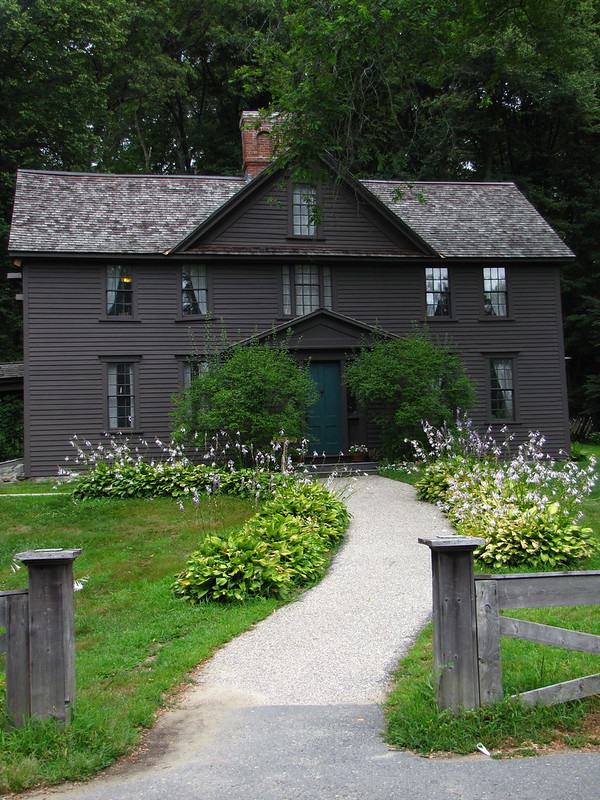
Although Alcott’s unconventional childhood was plagued with adverse hardship (the subject of another article), she was surrounded and shaped by extraordinary intellect. As a seven-year-old school girl, she and her classmates often followed their young teacher Henry David Thoreau into the woods to study nature or drifted down the Assabet and Sudbury Rivers on his boat the Musketaquid as he lectured about the history of the countryside. Furthermore, as an adolescent, Alcott idolized Ralph Waldo Emerson, a close family friend and benefactor, and she was allowed to borrow books from his library in Bush, his home a half mile walk back down Lexington Road and off Lowell Avenue.
And when budding author Nathaniel Hawthorne bought Hillside from the Louisa’s father for $1500 in 1852, the Alcotts and the Hawthornes became next door neighbors. (Hawthorne renamed the house Wayside). Only the children nurtured a friendship, however. Hawthorne was reportedly an introvert who avoided Bronson Alcott’s neighborly gestures.
Even if you’ve never taken the time to read Alcott’s work, the one-hour tour through Orchard House is captivating. In fact, walking through this two story brown clapboard house is like stepping into the novel itself. Alcott’s youngest sister May (the inspiration for Amy in the novel) rose to prominence as an artist. As in the book, her work graces many of the home’s walls including a portrait of an owl painted directly above the fireplace in Louisa’s bedroom. Not only has the house never been altered in the century and a half since the Alcott’s lived their, it contains 75% of its contents originally belonged to the family.
Concord’s Role in the Abolitionist Movement
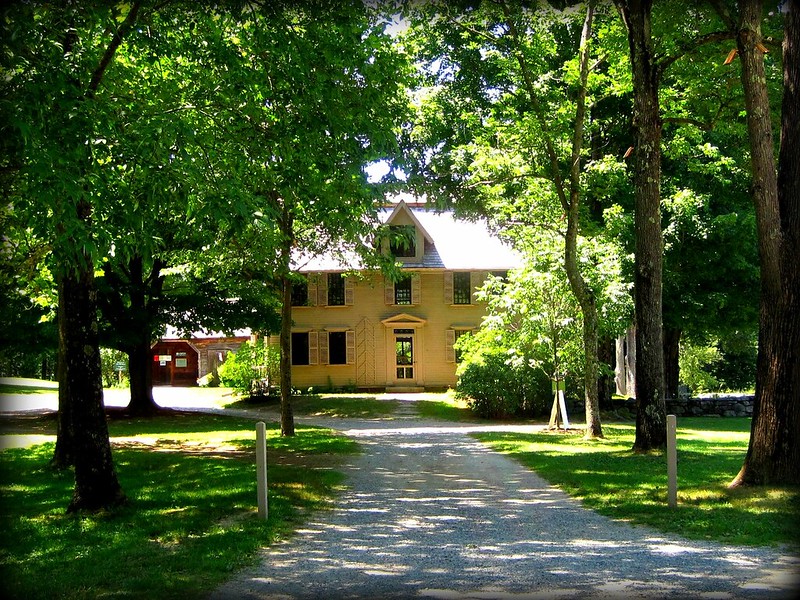
Image by Melanie McCue. CC / Flickr
There’s much more to see in Concord and to be honest, you can’t see it all in one day. Concord’s role in America’s abolitionist movement is another significant chapter in the community’s history. Bronson Alcott gained prominence as an abolitionist and the during the time the Alcott’s resided there, the Wayside was reportedly an important link in an Underground Railroad route to Canada. And the prior mentioned Old Manse was eventually the center of the abolitionist movement when John Brown spoke in the parlor in 1857. In fact, an entire day could be devoted to Concord’s African American history, alone. This African American History Map provides a self-guided walking tour highlights 40 sites which have a history integral to the movement.
I can’t speak for my husband, but due to its literary heritage, its historical significance, its friendly people, eclectic little shops and eateries, and idyllic small-town charm, Concord has edged out Boston as my favorite American town.
And Little Time Left for Lexington . . .
The day is rapidly disappearing, but at the very least, reserve an hour afternoon to visit the Minute Man Visitor Center in nearby Lexington. (Please note this center is only open from April 1 to October 31 with visiting hours from 9:00 am to 5:00 pm.) It features “The Road to Revolution” multi-media presentation which provides an excellent overview of the events leading up to the Revolutionary War and Lexington and Concord’s role.
This link provides another valuable self-guided tour of key battle and historic sites in both Lexington and Concord–yet a third day required for exploring the sites within the small margin of these two communities, if only time allowed.
On to Cape Cod
Plan a late afternoon departure for the two-hour journey south on I 495 to the Cape Cod coast and your evening accommodations for the next three nights in Hyannis Port/Yarmouth vicinity.

You’ll be arriving in the sleepy little town of Yarmouth in the early evening, but resist the urge to stop for supper along the Interstate. At the Hampton Inn hotel attendant’s recommendation, we had an excellent supper at the Yarmouth House, a quirky place with a water wheel and captivating character just down the road from the hotel. It was actually too late in the evening to order a heavy meal if we expected a good sound sleep that night, but we risked it. My husband ordered the baked scrod and I recall choosing a melt in your mouth risotto. However, my lasting memory is the sad moment when I scraped the last bite of creamy seafood bisque from the bottom of my bowl–this place is highly recommended.
We intended to return to the Yarmouth House later in the week for the apple crisp and the blueberry pie, but as you’ll quickly discover when you arrive in Cape Cod, there are many good food establishments vying for your taste buds.
DAYS 6 and 7: The Joy of Old Cape Cod
The final two days of your road trip are devoted exclusively to the unique culture of Cape Cod, a place I can’t seem to find the words to capture. Although we were both nearly 50 when we visited the Cape for the first time, there is something familiar about this location that caught me off guard. It seems to be reminiscent of the pleasant and safe places we internalized as ideal in our childhood. That is, those of us influenced by The Andy Griffeth Show, Beverly Cleary books, and the Norman Rockwell paintings on the covers of the twice monthly Saturday Evening Post. For even though its population swells with throngs of big city tourists in the summer months, every town on Cape Cod retains its friendly and slow-paced small town appeal.
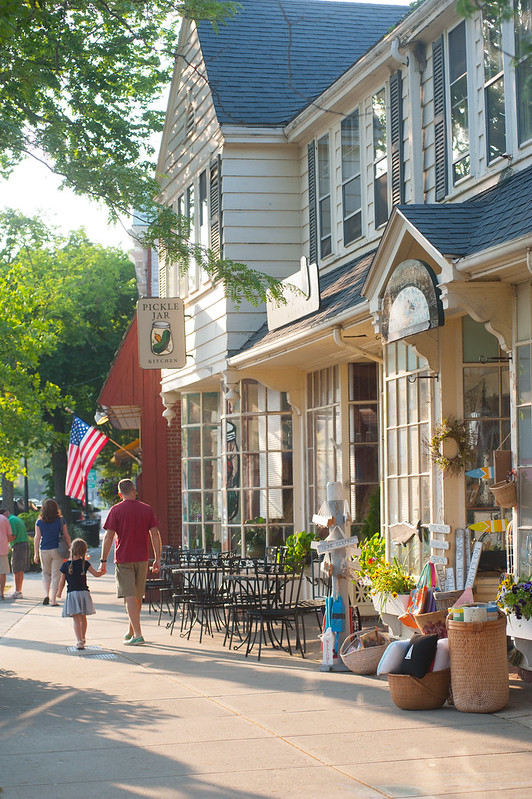
It’s also possible that familiar feeling originated with a song I often heard in my childhood. As a little girl in elementary school, I wasn’t sure where Cape Cod was located, but I longed to go there each time I heard Patti Page’s sensual voice blaring on the kitchen radio:
If you’re fond of sand dunes and salty air,
Quaint little villages here and there
You’re sure, you’re sure to fall in love with old Cape Cod . . .
Compared with the landscapes of the coastal communities farther south in the Carolinas, the golden isles of Georgia, or Florida, much of Cape Cod’s windswept shoreline seems to have a beauty all its own–almost haunting. I distinctly remember the warm afternoon we walked along the beach in the Cape Cod National Seashore with mammoth dunes to our left and formiddable wind-whipped waves to our right. Although I had seen the ocean many times, I had never experienced its magnitude as I did at that moment. We, my husband and I, were merely two meaningless specks of flesh in nature’s grand scheme. It was humbling to think how infinitesimally powerful the ocean waters were as they loomed beside us as far as our eyes could see, just like they had for millions of years before we existed and will continue to do so after we are gone.
We were happy for pie and coffee afterwards.
Cape Cod is seventy miles long and twenty miles wide at its broadest and a mere mile wide at its eastern most tip which hardly seems to contain its beautiful landscapes–shifting dunes, groves of oak and pine, clusters of little shops and cottages, and cranberry bogs.

I love how the peninsula’s northern sea breezes have weathered the clapboard and shingled siding on many of the older houses along the coast– cape and bayside–to Provincetown. I love the lined and leathery tanned patina on many of the faces of men and women who have lived on Cape Cod for decades. I love traveling along rural roads that suddenly reveal an old general store with jams and jellies and syrups and a little bit of everything else on its shelves. I love to listen to the voices of true Cape Codders–(and many New Englanders)–they don’t bother with the final “r” in many of their words.
And, my husband loves the bakeries and the pie–blueberry, cranberry and clam, both sweet and savory.
Plan a Visit to Nantucket
We spent an entire week on Cape Cod a few years back, so it’s hard to confine the many possible activities to two days. One of those days should be spent in Nantucket, however. Many are lured to Martha’s Vineyard with its gingerbread houses and status as a celebrity retreat. Instead, we prefer the one-hour ferry ride from Hyannis Port to historic Nantucket island–be sure to upgrade to first class for a few dollars more and the hour will speed by.
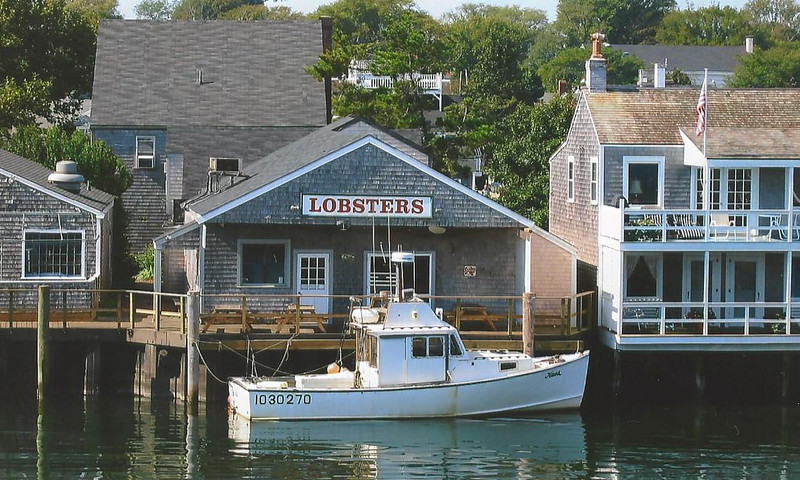
Originally, Nantucket island was home to the Wampanoag, native Americans who apparently lived there happily until the English arrived in 1641. In that year, Englishman Thomas Mayhew of Watertown, Massachusetts, was deeded the land by the Earl of Stirling and the demographics of the island changed from that point.
Nantucket island gained prominence in the early 19th century with the whaling industry, and its prosperous tourist industry still trades on this legacy today. In fact, it’s the stomping ground of Melville’s fictional Captain Ahab in his novel Moby Dick (1851).
Nantucket’s heritage as a Quaker colony is probably lesser known, but by 1760 the island was home to one of the larger Quaker Meeting Houses in America. Church Elder, Mary Starbuck formed the Nantucket Meeting which reached a population of 2400 by 1762.
Established in England by George Fox in 1650, the of Friends or Quakers were considered religious radicals by the mainstream Anglicans and met with significant persecution. Many died in prison in England, and when they sought religious freedom in the New World, they found even harsher treatment in Massachusetts. The New World Quakers’ practices clashed with Puritan doctrine because the Quakers refused to take oaths, pay church taxes, and they denounced rank of any kind. Consequently, some Quakers were even hanged. Furthermore, those who attempted to communicate with Quakers were fined.
The Quaker faith gained a foothold on Nantucket, however, in the early 1700’s. Many Quakers thrived here financially as they invested in the whaling trade and, in turn, their practical sense of living influenced much of the island’s architecture and political climate that exists today.
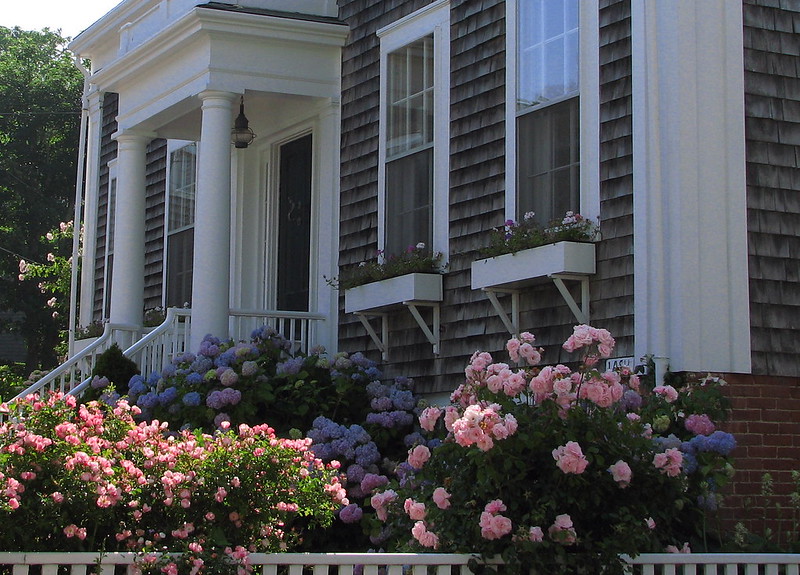
In fact, today Nantucket island is a designated National Historic Landmark District, which the National Park Service cites as “the finest surviving architectural and environmental example of a late eighteenth and early nineteenth century New England seaport town” (“Nantucket Historic District”). The weathered gray houses with white trim, pop with bursts of geraniums or pansies, overflowing from window boxes or pots by their doors. Although this architectural style may seem austere to some, walking the narrow streets with the small fenced white picket fences and well kept little gardens is like stepping into an 18th century novel. Our stay was far too short.
I remember the overcast day in May, following Main Street up to Madaket Road. There, far past the tourist boutiques and eateries, we found the burying grounds epitomized in Robert Lowell’s 1947 poem “Quaker Graveyard in Nantucket.” As my husband and I stood at the threshold of that cemetery, sparse with headstones, a hundred unspoken family tragedies came to life, whalers and sailors lost at sea through many generations. If I ever write an article about Nantucket, that’s the moment I’ll capture most accurately in writing. I don’t recall what we ate or what trinkets we purchased.

If you plan for an early arrival and departure from Nantucket you may still be able to squeeze in more attractions on your first full day in Cape Cod. Excursions might include whale-watching or the Cape Cod Potato Chip Factory and the Sandwich Glass Museum. Or, you can explore the streets of Hyannis including the JFK Museum and the Cape Cod Maritime Museum. Or, if your sense of humor leans toward the macabre, you’ll enjoy New Yorker cartoonist Edward Gorye’s home at 7 Strawberry Lane in Yarmouth. The house is open to visitors at odd hours from April to December, so call ahead to avoid disappointment.
And for your Final Day on Cape Cod . . .
Don’t be tempted to linger in bed when Day 7 arrives if you hope to take in even a portion of the remaining activities Cape Cod has to offer.
We recommend Provincetown as the day’s destination with morning stops at the Cape Cod National Seashore Visitor’s Center with its 40 miles of breathtaking Atlantic shoreline and Highland Lighthouse.

With limited time to spend on the cape, the Salt Pond Visitor Center within the Cape Cod National Seashore is a practical choice. It features a variety of films during visiting hours including “Standing Bold,” focusing on the geological elements of Cape Cod. Additional short films provide an overview of the area’s history and culture. The visitor center is located approximately 25 miles from the hotel on Highway 6 just past the community of Eastham.
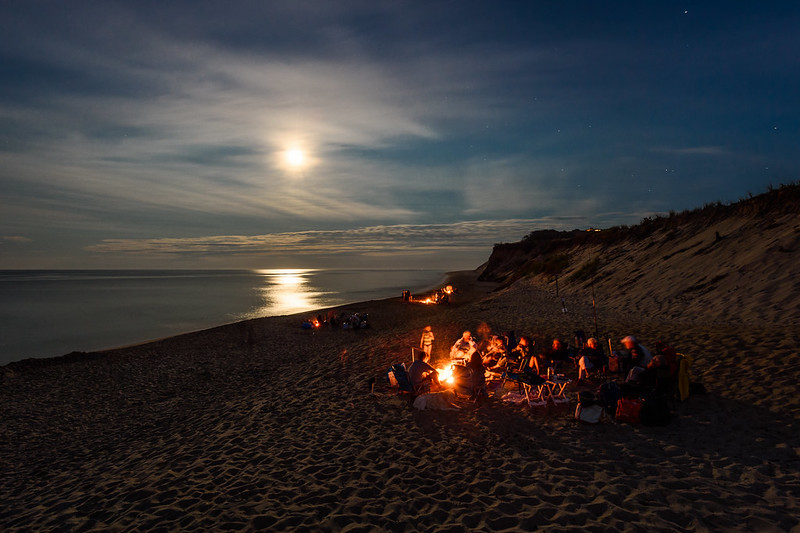
Approximately 10 miles farther east from the visitor center on Highway 6 is another place of significance located within the national park, although nothing remains of the historical structure. If you take the Marconi Station Exit and follow the Marconi Exit Road approximately three and a half miles, you will arrive at the site once referred to as “the voice of America.” It was here on January 18, 1903 that inventor Guglielmo Marconi transmitted the first wireless radio message from one continent to the next. With his kerosene powered engine, Marconi generated the 25,000 volts necessary to send a message to a similar station in Podhu in the Cornwall region of England.
The Wellfleet Station as it was called was in operation for 15 years, with messages sent between 10:00 pm and 2:00 am when atmospheric conditions were best. It was eventually closed in 1917 to protect national security with the advent of WWI and never reopened. New York Times best-selling author Erik Larsen’s novel Thunderstruck (2006) highlights Marconi’s effort with fascinating detail as it chronicles the process in which the transcontinental telegraph was used to bring British murderer Hawley Harvey Crippen to justice.
And, approximately five miles further east on Highway 6, is a final morning stop–Highland Lighthouse, also located within the national park. Although Cape Cod boasts five lighthouses, Highland Light, located within the National Seashore, is its oldest and tallest. George Washington commissioned the first structure in 1797 which was erected on a 125 foot cliff on the outer banks of the Cape near its easternmost tip between Truro and North Truro. However, due to the cliff’s erosion, two previous structures were demolished and the current 66-foot tall structure was erected in 1857. Still a beacon to ships today with its new LED light installed in 2017, the National Coast Guard maintains the structure as a navigation source.
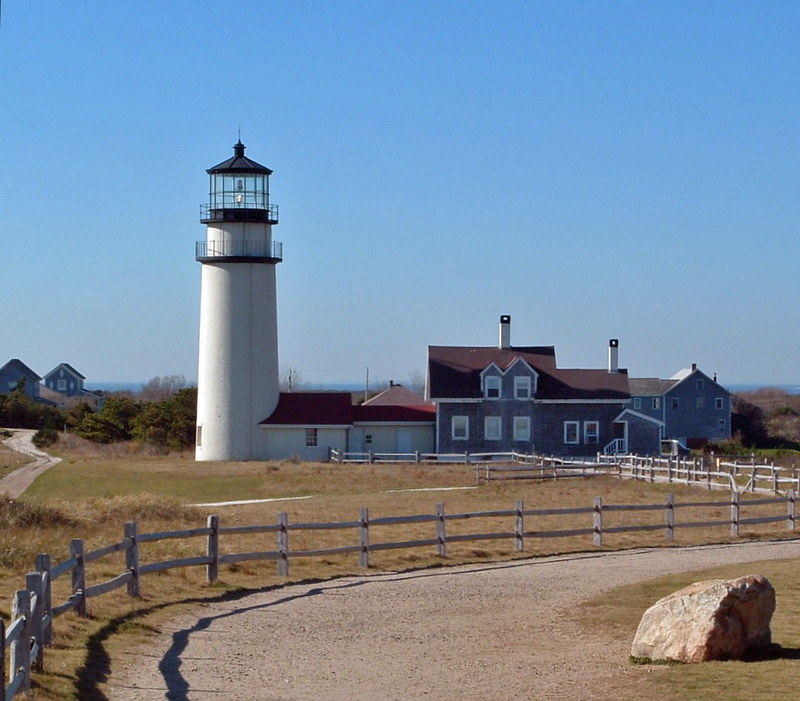
The lighthouse is listed on the National Register of Historic Places and is the subject of Edward Hopper’s painting “Highlight Lighthouse, North Truro” (1930), now housed in Harvard’s Fogg Museum. Hopper lived in a home he and his wife built facing the Atlantic near North Truro and captured many Cape Cod scenes in his watercolors on display at art museums across the country.
Henry David Thoreau also visited the lighthouse several times and was apparently a guest of the lighthouse keeper. He captured his experience in an Atlantic Monthly article in 1865:
“I thought as I lay there, half-awake and half-asleep, looking upward through the window at the lights above my head, how many sleepless eyes from far out on the ocean stream — mariners of all nations spinning their yarns through the various watches of the night — were directed toward my couch” (“Cape Cod (1865) Thoreau/The Highland Light”).
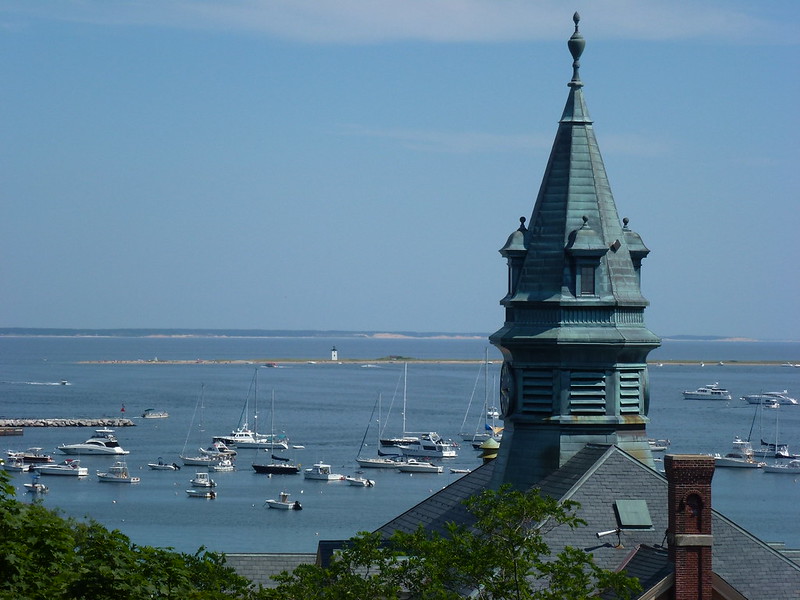
Image by Massachusetts Office of Travel and Tourism. CC / Flickr
Grab some lunch at one of many restaurants in Provincetown, ten miles from Highland Light. Provincetown marks the original point where the Pilgrims set anchor in 1620.
If time allows, climb the 116 steps to the top of Pilgrim’s Monument completed in 1910 to commemorate the Pilgrim’s Landing and the signing of the Mayflower Compact in Provincetown Harbor four centuries ago. We also recommend the Provincetown Museum, with its thoughtfully planned exhibits and artifacts dedicated to Provincetown’s local history and especially the pomp and circumstance of the monument’s construction. President Teddy Roosevelt arrived to officiate the laying of tower’s cornerstone in 1907 and President William Howard Taft arrived three years later to dedicate the monument at a ceremony.
The $14 entrance fee per adult for the tower and the museum is money well spent. Please note the attraction is closed during the winter months.
Today, Provincetown is a thriving artists’ community. This small coastal resort town at the eastern most tip of Cape Cod, swells to a population of 60,000 at the height of the summer season.
As the afternoon winds down, the return trip from Provincetown to your Hampton Inn home base in Yarmouth is about 50 miles and and an hour’s drive.
DAY 8: A Last Look at Boston and Departure for Home
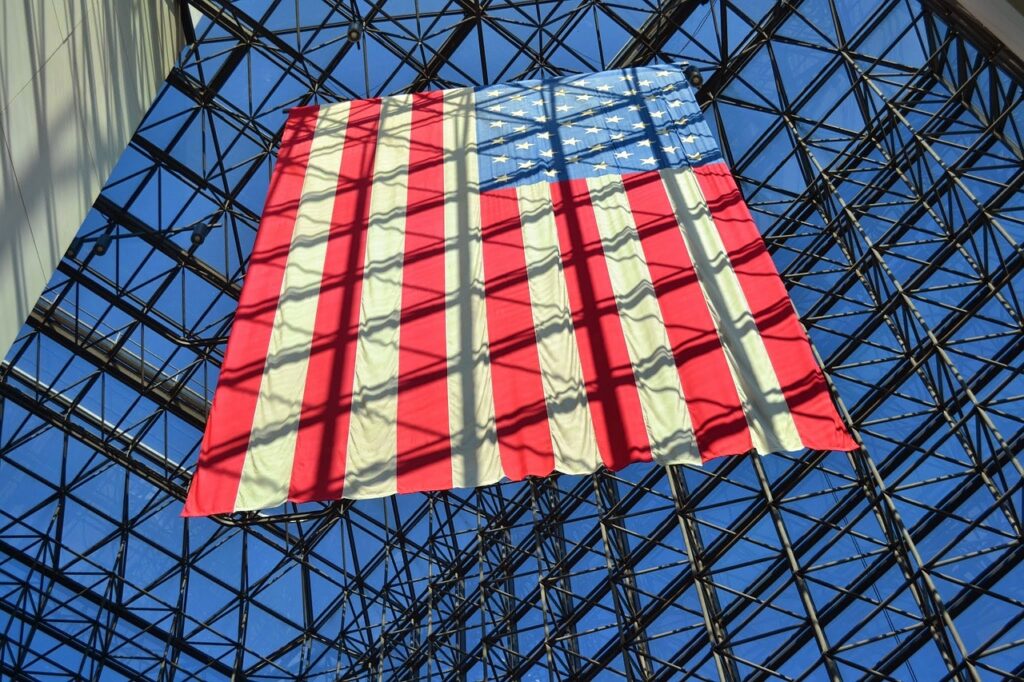
If you’ve booked a later afternoon flight out of Boston Logan, there is still time to take in one more of Boston’s premier attractions and we recommend the JFK presidential library. This museum is easily accessed of I 93 on your route from Hyannis Port/ Yarmouth to Logan and provides an insightful trip back in the 1960s and John Fitzgerald Kennedy’s 1000 days in office.
Large screen projections, interactive exhibits, and hundreds of artifacts chronicle Kennedy’s life. Many permanent exhibits include memorabilia from his boyhood and the Kennedy family, the space program, the Kennedy’s life in the White House, Jacqueline Kennedy’s gowns, and 106 fascinating gifts presented to Kennedy from global heads of state. Of particular interest is the Oval Office exhibit with footage from the Civil Rights movement and Kennedy’s efforts to end racial discrimination which he called a “moral disgrace.”

The museum’s most poignant artifact, however, is Kennedy’s sailboat, the Victura, purchased by his family when he was just 15 years old. The 90-year-old boat, situated in a protected spot on the lawn, was a treasured possession for the remainder of Kennedy’s life. His adventures in the boat are documented in many family pictures and film footage.
If you aren’t a fan of airport food, the museum is also an ideal place for an inexpensive lunch in a cafe overlooking Boston Harbor, and the Boston skyline. Afterward, Boston Logan is approximately ten miles from the JFK library, but allow at least an hour to maneuver through mid-day traffic.
Sadly, as your vacation comes to a close, you’ve only seen a fraction of what Massachusetts let alone great New England has to offer.
Next installment: Maine: It’s Pristine Wilderness and Bustling Seaside Towns
A special thanks to the vast community of photographers on Flickr and Pixabay willing to share their work in Creative Commons. They’re far better picture takers than we are.
Brooks, Rebecca Beatrice. “Reverend Samuel Parris: Was He to Blame for the Salem Witch Trials?” History of Massachusetts Blog, 8 September 2015, retrieved on 15 November 2019 from https://historyofmassachusetts.org/reverend-samuel-parris/
Burton, Tara Isabella. “There Weren’t Any Witches in Salem in 1693. But There Sure Are Now: How We See Salem’s Witches Tells Us More About the Present Than the Past.” Vox, 30 October 2017, retrieved on 15 November, 2019 from https://www.vox.com/identities/2017/10/30/16560092/salem-witch-trials-magic-halloween-witchcraft-arthur-miller-crucible-past
“Cape Cod (1865) Thoreau/The Highland Light.” WikiSource. Retrieved 2 January 2020 from https://en.wikisource.org/wiki/Cape_Cod_(1865)_Thoreau/The_Highland_Light
Dalton, Tom. A Dummies Guide to Salem Witches: From Witchcraft School to Vampire Balls and Everything In Between.” The Salem News, 10 October 2007, retrieved on 16 November 2019 from https://www.salemnews.com/archives/a-dummies-guide-to-salem-witches-from-witchcraft-school-to/article_8280d66f-3982-5fbf-992f-b13f4bcd81de.html
Emerson, Ralph Waldo. “Address at the Consecration of Sleepy Hollow Cemetery.” The Later Lectures of Ralph Waldo Emerson: 1843 – 1871, University of Georgia Press, retrieved on 17 November from Google Books.
“Nantucket Historic District.” Maritime History of Massachusett. National Park Service, retrieved 31 December from https://www.nps.gov/nr/travel/maritime/index.htm
Schiff, Stacy. “First, Kill the Witches. Then Celebrate Them.” The New Yorker, 24 October 2015, retrieved on 15 November 2019 from https://www.nytimes.com/2015/10/25/opinion/sunday/first-kill-the-witches-then-celebrate-them.html
Schiff, Stacy. “Inside the Salem Witch Trial: Diabolical Doings in a Puritan Village.” The New Yorker, 31 August, 2015, retrieved on 15 November 2019 from https://www.newyorker.com/magazine/2015/09/07/the-witches-of-salem
